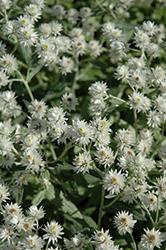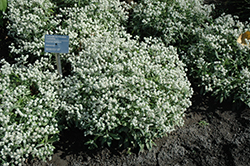Triple-nerved Pearly Everlasting
Anaphalis triplinervis
Height: 18 inches
Spread: 24 inches
Sunlight:
![]()
Hardiness Zone: 1
Other Names: syn. Anaphalis nepalensis
Description:
A bushy, low mounded plant with narrow gray green foliage, producing masses of small white button flowers that cover the plant in summer; excellent as edging, or massed along borders
Ornamental Features
Triple-nerved Pearly Everlasting has masses of beautiful white button flowers with yellow eyes at the ends of the stems from early summer to early fall, which are most effective when planted in groupings. The flowers are excellent for cutting. Its attractive tomentose narrow leaves emerge silver in spring, turning grayish green in color throughout the season.
Landscape Attributes
Triple-nerved Pearly Everlasting is an herbaceous perennial with a mounded form. It brings an extremely fine and delicate texture to the garden composition and should be used to full effect.
This plant will require occasional maintenance and upkeep, and should be cut back in late fall in preparation for winter. It is a good choice for attracting butterflies to your yard. Gardeners should be aware of the following characteristic(s) that may warrant special consideration;
- Spreading
Triple-nerved Pearly Everlasting is recommended for the following landscape applications;
- Border Edging
- General Garden Use
- Naturalizing And Woodland Gardens
Planting & Growing
Triple-nerved Pearly Everlasting will grow to be about 18 inches tall at maturity, with a spread of 24 inches. Its foliage tends to remain dense right to the ground, not requiring facer plants in front. It grows at a fast rate, and under ideal conditions can be expected to live for approximately 8 years. As an herbaceous perennial, this plant will usually die back to the crown each winter, and will regrow from the base each spring. Be careful not to disturb the crown in late winter when it may not be readily seen!
This plant should only be grown in full sunlight. It prefers to grow in average to moist conditions, and shouldn't be allowed to dry out. It is not particular as to soil type or pH, and is able to handle environmental salt. It is highly tolerant of urban pollution and will even thrive in inner city environments. This species is not originally from North America. It can be propagated by division.

